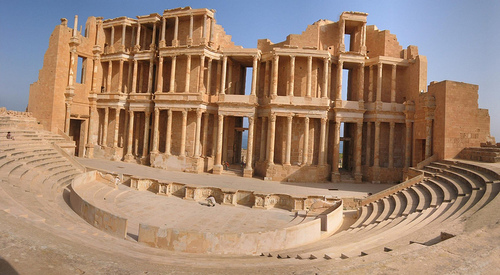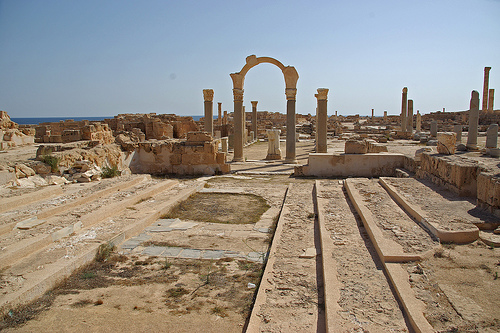

Location: 40 km East of Zuwarah, Zawiya District Map
When to visit: May- Sept

Sabratha
Archaeological Site is located 40 km East of Zuwarah in Zawiya
District in Libya. Sabratha Archeological Site is best known for its
impressive roman ancient ruins dating from the time of the Roman
Empire. The history of Sabratha starts much earlier. Initially it
was found by the local Berber tribes of Zwagha that also gave a name
to their settlement. Expanding influence of Phoenicians soon arrived
in the first millennium BC. This sea- faring nation established
their trade post. Initially these were temporary settlements with
many tents that were easily put up then the traders came to trade
and then taken down once the trade was over. By fifth century BC
Phoenicians start to settle in Sabratha permanently. Their stone
houses and artifacts started to show up more often in more recent
strata during archaeological digs.
Milder climate and great
irrigation techniques made North Africa and important supplier of
grain to all of the Mediterranean. According to Roman historian
Pliny the Greeks even called it Abroton that means "grain market".
The Latin form of that was Habrotonum. Neo- Punic coins spelled the
name as Sabrat. Sabratha, being part of Numidian Kingdom played an
important part during Punic wars. Its king Massinissa finally chose
side of the Romans and helped to speed the end of the war. His
grandson Jugurtha on the other hand was famous for his wars with the
Roman Republic. He eventually lost the war and died of starvation in
Roman prison in the mid- 2nd century BC. His kingdom including
Sabratha became part of Roman possession. With the establishment of
an empire the city grew significantly in the second and third
centuries adding a majestic theatre that could seat over 5,000
spectators and temples devoted to many gods including those from
Egypt. It became a common practice to worship many Egyptian gods
throughout the Empire. Temples of Serapis and Isis is one of the
best preserved in the city and also one of the most beautiful.
Sabratha also has an honour of being the home city of Lucius
Apuleius, famous author of the Metamorphoses.
The earthquake
of 365 AD caused much hardship to Sabratha by disrupting its
infrastructure and damaging irrigation fields. The invasion of the
Vandals from Europe in the 455 AD completely destroyed erased
Sabratha from the map. Some survivors probably lived in the area,
but the city it seems never recovered. Lack of walls that the
Vandals tore down left the city defenceless. There were attempts to
resettle the area by the Byzantines, but these ultimately failed.
Thanks to isolation of this archaeological site there were very
little looting or reuse of Sabratha's stone. This practice destroyed
many sites in Europe, but Northern Africa can still show the
splendour of its Roman past.

History
Along with Oea and Leptis Magna, Sabrata was one of
the three cities after which the region of Tripolitania was named in
ancient times. In Sabrata there are well-preserved and painstakingly
reconstructed ruins from the Roman era, e.g. the Theater Welt-Icon,
the Temple of Isis and the Agora. Excavated by Kathleen Kenyon
between 1948 and 1951, the site was inscribed on the UNESCO World
Heritage List in 1982.
The city was founded in the 5th
century BC. Founded by the Phoenicians from Tyros, it became an
important shipping port on the sea routes of the western
Mediterranean and soon came under the control of Carthage. This
quickly prospered the citizens of Sabrata, as it had one of the few
natural harbors in Tripolitania and was also located at the junction
of the coastal road and a trade route of the Trans-Saharan caravans
leading south through the Sahara. The Carthaginians therefore judged
here in the 5th century BC. set up a trading post and traded there
with the indigenous tribes. During Roman rule (since 46 BC), the
city experienced an economic boom as an important commercial center
of Roman Tripolitania. The city was elevated to a colonia in the 2nd
century AD. A number of bath buildings and the theater from the
Antonine period survive from this period. Around the year 200,
numerous public buildings were again elaborately decorated with
expensive marble; At that time, up to 20,000 people still lived in
the city.
The decline of the ancient city coincided with the
slow dissolution of the Western Roman Empire as incursions by camel
nomads affected agriculture and a major earthquake struck the city
in 365. In 363 the Austuriani raided and sacked Sabrata. In the 5th
century the Vandals first occupied the city, in the 6th century AD
the Byzantines and the city enjoyed a second heyday as part of the
Byzantine Empire. New fortifications were also built during this
period, although they enclosed a much smaller area than in earlier
times. Byzantine rule ended around AD 643 when North Africa was
overrun by Arab troops. After the Muslim conquest in the 7th
century, Sabrata quickly declined in importance; Instead, Oea now
rose under the name Tripoli to become the new economic center of the
province of Ifrīqiya.
center of the smuggling business
The
Sabrata region has become particularly well-known as a result of the
refugee crisis in Europe and is considered the starting point for
illegal migration across the Mediterranean. Sabrata is just 300
kilometers south of the Italian island of Lampedusa. In August 2017,
the Reuters news agency reported that a militia, the martyr Anas al
Dabbashi's brigade, had seized control of the port of Sabrata, the
logistical center of the smugglers. In Sabrata, the militia now
ruled under the leadership of Ahmed Dabbashi. In January 2017, the
government of national unity also stationed the 48th infantry
battalion in Sabrata to work with the militia to combat human
smuggling.